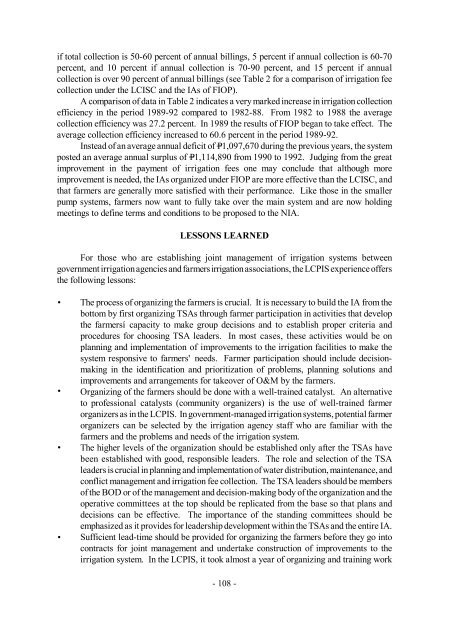Organizational Change for Participatory Irrigation Management
Organizational Change for Participatory Irrigation Management
Organizational Change for Participatory Irrigation Management
Create successful ePaper yourself
Turn your PDF publications into a flip-book with our unique Google optimized e-Paper software.
if total collection is 50-60 percent of annual billings, 5 percent if annual collection is 60-70<br />
percent, and 10 percent if annual collection is 70-90 percent, and 15 percent if annual<br />
collection is over 90 percent of annual billings (see Table 2 <strong>for</strong> a comparison of irrigation fee<br />
collection under the LCISC and the IAs of FIOP).<br />
A comparison of data in Table 2 indicates a very marked increase in irrigation collection<br />
efficiency in the period 1989-92 compared to 1982-88. From 1982 to 1988 the average<br />
collection efficiency was 27.2 percent. In 1989 the results of FIOP began to take effect. The<br />
average collection efficiency increased to 60.6 percent in the period 1989-92.<br />
Instead of an average annual deficit of P=1,097,670 during the previous years, the system<br />
posted an average annual surplus of P=1,114,890 from 1990 to 1992. Judging from the great<br />
improvement in the payment of irrigation fees one may conclude that although more<br />
improvement is needed, the IAs organized under FIOP are more effective than the LCISC, and<br />
that farmers are generally more satisfied with their per<strong>for</strong>mance. Like those in the smaller<br />
pump systems, farmers now want to fully take over the main system and are now holding<br />
meetings to define terms and conditions to be proposed to the NIA.<br />
LESSONS LEARNED<br />
For those who are establishing joint management of irrigation systems between<br />
government irrigation agencies and farmers irrigation associations, the LCPIS experience offers<br />
the following lessons:<br />
The process of organizing the farmers is crucial. It is necessary to build the IA from the<br />
bottom by first organizing TSAs through farmer participation in activities that develop<br />
the farmersí capacity to make group decisions and to establish proper criteria and<br />
procedures <strong>for</strong> choosing TSA leaders. In most cases, these activities would be on<br />
planning and implementation of improvements to the irrigation facilities to make the<br />
system responsive to farmers' needs. Farmer participation should include decisionmaking<br />
in the identification and prioritization of problems, planning solutions and<br />
improvements and arrangements <strong>for</strong> takeover of O&M by the farmers.<br />
Organizing of the farmers should be done with a well-trained catalyst. An alternative<br />
to professional catalysts (community organizers) is the use of well-trained farmer<br />
organizers as in the LCPIS. In government-managed irrigation systems, potential farmer<br />
organizers can be selected by the irrigation agency staff who are familiar with the<br />
farmers and the problems and needs of the irrigation system.<br />
The higher levels of the organization should be established only after the TSAs have<br />
been established with good, responsible leaders. The role and selection of the TSA<br />
leaders is crucial in planning and implementation of water distribution, maintenance, and<br />
conflict management and irrigation fee collection. The TSA leaders should be members<br />
of the BOD or of the management and decision-making body of the organization and the<br />
operative committees at the top should be replicated from the base so that plans and<br />
decisions can be effective. The importance of the standing committees should be<br />
emphasized as it provides <strong>for</strong> leadership development within the TSAs and the entire IA.<br />
Sufficient lead-time should be provided <strong>for</strong> organizing the farmers be<strong>for</strong>e they go into<br />
contracts <strong>for</strong> joint management and undertake construction of improvements to the<br />
irrigation system. In the LCPIS, it took almost a year of organizing and training work<br />
- 108 -
















